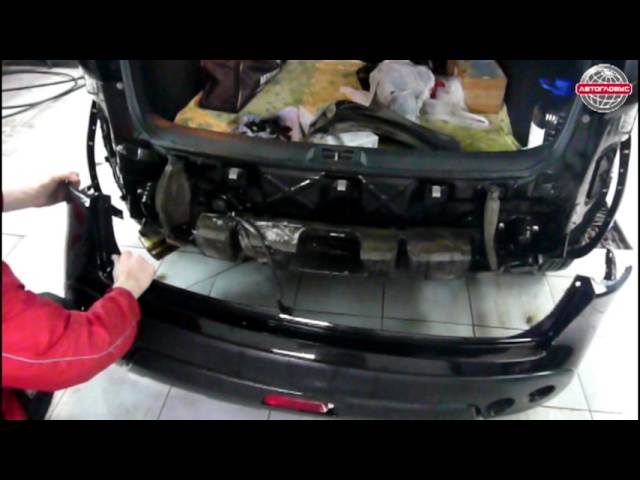
MAZ 543 Hurricane
Content
- History of creation and production
- An unexpected decision on the choice of the layout of the cabin MAZ-543
- Operation of military equipment
- Specifications MAZ-543
- Basic model MAZ-543
- Engine and transmission
- Fire fighting modifications
- Intermediate and single line machines
- Features MAZ-543A
- Maz 543 - Hurricane tractor: specifications, photo
- Various prototypes and small-scale vehicles produced on the basis of the MAZ-543
- Specifications and comparison with analogues
- Features MAZ-543M
- MAZ 537: price, specifications, photos, reviews, dealers MAZ 537
- Fire trucks MAZ-543 "Hurricane"
- Basic Modifications
After mastering the production of the MAZ 537 series at the Minsk Automobile Plant, a group of engineers from Yaroslavl was sent to Minsk, whose task was to develop a new combat vehicle using the basis and developments used to create the MAZ-537.
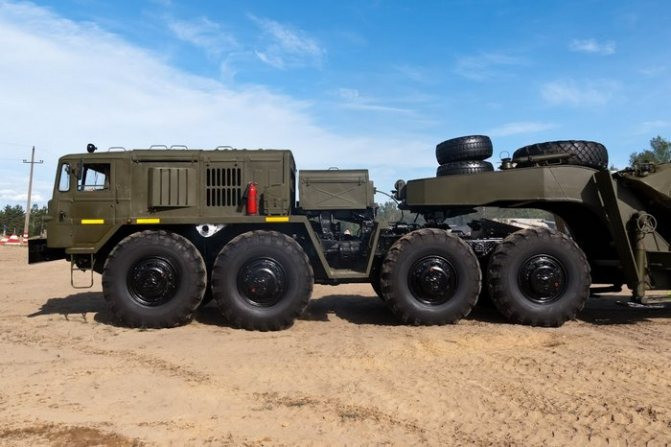
The MAZ-543 car began to be developed in the late 1950s. For this, the special design bureau No. 1 under the leadership of Shaposhnikov used all its accumulated knowledge since 1954. With the help of Yaroslavl engineers in 1960, the MAZ-543 chassis project was ready. The Soviet government reacted very quickly to this news and issued a decree on December 17, 1960 ordering the production of the MAZ-543 chassis to begin as soon as possible.
After 2 years, the first 6 samples of the MAZ-543 chassis were ready. Two of them were immediately sent to Volgograd, where experimental rocket launchers and R-543 ballistic missiles with rocket engines were installed on the MAZ-17 chassis.
The first completed missile carriers were sent to the training ground in Kapustny Yar in 1964, where the first design tests were carried out. During testing, the MAZ-543 chassis performed well, since SKB-1 had experience in developing machines of this type since 1954.
History of creation and production
During the First World War, cars proved that they could bring the mobility of troops to a qualitatively new level. And after the Great Patriotic War, the emergence of new types of weapons forced us to design equipment that could carry them.
The creation of military tractors with high cross-country ability was entrusted to a special design bureau and the MAZ experimental workshop. The family of cars was named MAZ-535 - the first prototypes were built already in 1956, and in 1957 the trucks successfully passed the test cycle. Serial production began in 1958.
The family also included the MAZ-535V truck tractor, designed primarily for the transport of tracked vehicles (including tanks). It turned out to be the most demanded machine, but almost immediately it became clear that its power was not enough to effectively transport the latest weapons with a larger mass.
To solve this problem, they developed their own version with an engine power up to 525 hp. He received the name MAZ-537. For some time, cars were produced in parallel, but in 1961 the production of MAZ-535 was transferred to a plant in Kurgan. In 1964, MAZ-537 also chased him - production of the famous Hurricane MAZ-543 was launched in Minsk.
In Kurgan, the MAZ-537 quickly ousted its predecessor from the assembly line.
Tractors carried tanks, self-propelled guns, rocket launchers and light aircraft. In the national economy, the truck also found application - it turned out to be indispensable for transporting heavy loads in conditions, for example, of the Far North. During production, as a rule, minor changes were made to cars, such as the unification of lighting equipment with “civilian” trucks, or the introduction of other air intakes for the cooling system.
In the 80s, they tried to modernize the tractors - they installed the YaMZ-240 engine and tried to improve ergonomics. But the age of the structure affected, and in 1990 the MAZ-537 tractor was finally discontinued.
After the collapse of the Soviet Union, MAZ remained in independent Belarus, and the plant in Kurgan, which lost defense orders and did not receive assistance in the form of the production of civilian vehicles, quickly went bankrupt.
An unexpected decision on the choice of the layout of the cabin MAZ-543
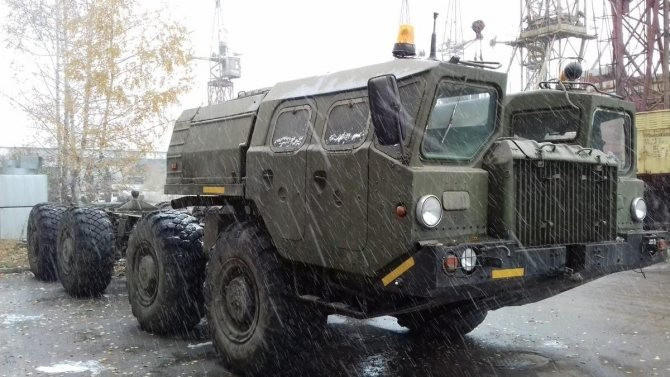
The new missile system, called "Temp-S", had a very long missile (12 mm), so the length of the chassis was clearly not enough. It was decided to make a special recess in the middle of the cabin, but this was not implemented. Since it only remained to lengthen the frame, the chief designer Shaposhnikov made a very bold and extraordinary decision - to divide the large cabin into two isolated cabins, between which the rocket head was placed.
Such a division of the cabin has never been used on such a technique, but this method turned out to be the only correct solution. In the future, most of the predecessors of the MAZ-543 had cabins of this type. Another original decision was the use of new material to create the cabins of the MAZ-543. They were not made of metal, but of polyester resin reinforced with fiberglass.
Although many skeptics immediately appeared who argued that the use of a plastic-like material for the cockpit was unacceptable, tests in the cockpit showed the opposite. During impact testing, the test rig collapsed, but the cabin survived.
Mounted armor plates were developed especially for the cabin. Since the MAZ-543 had to fit into the railway format without fail, taxis received 2 seats each, and the seats were located not in one row, but one after another.
Operation of military equipment
Appropriately trained drivers can drive such a large vehicle. First of all, it is necessary to pass exams on knowledge of the same spare parts, safety precautions and, of course, driving itself. In general, the standard crew of the car consists of two people, so they must work together.
New technology needs to be introduced. First, after a run of 1000 km, the first MOT is carried out. Also, after two thousand kilometers, an oil change is carried out.
Before starting the engine, the driver pumps the lubrication system with a special pump (pressure up to 2,5 atm) for no more than a minute. If the temperature is below 5 degrees, the engine must be warmed up before starting - there is a special heating system for this.
After stopping the engine, restarting it is allowed only after 30 minutes. After flushing at low temperatures, a power plant is started to remove water from the turbine.
Thus, the vehicle was idle for a long time at an ambient temperature of less than 15 degrees. Then the hydromechanical gearbox with overdrive turned itself off.
It is worth noting that the reverse speed is activated only after a complete stop. When driving on a hard surface and dry ground, a higher gear is engaged, and in off-road conditions a lower gear is engaged.
When stopping on a slope of more than 7 degrees, in addition to the hand brake, the drive of the master cylinder of the brake system is used. Parking should not exceed 4 hours, otherwise wheel chocks are installed.
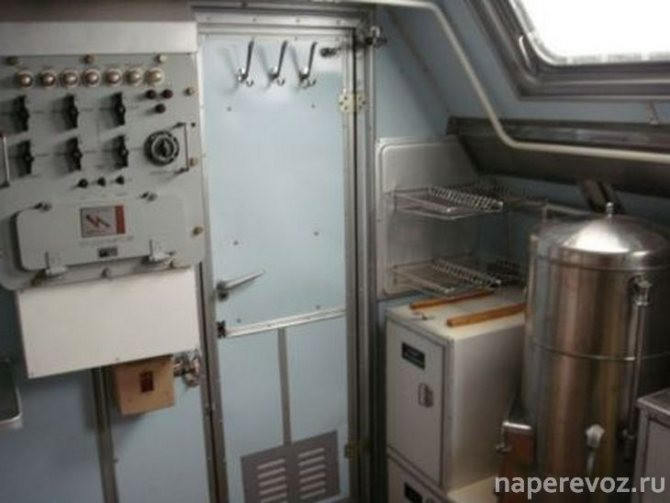
Specifications MAZ-543

When designing the MAZ-543, many original design solutions were applied:
- The initial frame consisted of 2 bent stringers of increased elasticity. For their manufacture, welding and riveting technologies were used;
- To ensure the necessary smoothness, an independent suspension of a torsion-lever type was chosen;
- The transmission was also very original. A four-speed hydro-mechanical transmission allowed gear changes without power interruption;
- The patency of the car was provided by 8 driving wheels, each of which had an automatic pumping system. By adjusting the tire pressure, it was possible to achieve high cross-country performance even on the most difficult off-road sections;
- The D-12A-525 tank engine provided the vehicle with the necessary power reserve. The volume of this 525-horsepower 12-cylinder engine was 38 liters;
- The car had 2 fuel tanks with a capacity of 250 liters each. There was also an additional 180-liter aluminum tank. Fuel consumption could range from 80 to 120 liters per 100 km;
- The carrying capacity of the chassis was 19,1 tons, and the curb weight was about 20 tons, depending on the modification.
The dimensions of the MAZ-543 chassis were dictated by the dimensions of the rocket and the launcher, so earlier in the terms of reference they were indicated:
- The length of the MAZ-543 was 11 mm;
- Height - 2900mm;
- Width - 3050 mm.
Thanks to the separate cabins, it was possible to place the Temp-S launcher on the MAZ-543 chassis without any problems.
Basic model MAZ-543

The first representative of the MAZ-543 family of vehicles was the base chassis with a carrying capacity of 19,1 tons, called the MAZ-543. The first chassis under this index were assembled in the amount of 6 copies in 1962. In total, 1631 copies were produced in the entire history of production.
Several MAZ-543 chassis were sent to the GDR army. There they were equipped with all-metal tent bodies, which could be used both for the transport of goods and for the transport of personnel. In addition, MAZs were equipped with powerful trailers, which made them powerful ballast tractors. Those vehicles that were not used as tractors were converted into mobile workshops or recovery vehicles.
MAZ-543 was originally designed to accommodate operational-tactical missile systems on its chassis. The first complex, which was placed on the MAZ-543 chassis, was TEMP. After that, a new 543P9 launcher was mounted on the MAZ-117 chassis.
Also, on the basis of MAZ-543, the following complexes and systems were assembled:
- Coastal missile complex "Rubezh";
- Combat checkpoints;
- Special military truck crane 9T35;
- communication stations;
- Autonomous diesel power plants.
On the basis of the MAZ-543, other specific equipment was also installed.
Engine and transmission
MAZ 543, whose technical characteristics are similar to MAZ 537, also has a similar engine, but with direct fuel injection and an air cleaner. It has a twelve-cylinder V-configuration, a mechanical speed control in all modes, and is powered by a diesel engine. The diesel engine was based on the B2 used in tanks during the war. Volume 38,8 liters. Engine power - 525 hp.
The hydromechanical transmission used on the MAZ 543 facilitates driving, increases off-road patency and engine durability. It consists of three parts: four wheels, a single-stage torque converter, a three-speed automatic transmission and a control system.
The machine is equipped with a mechanical transfer case, which has two stages with a central differential.
Fire fighting modifications
Airfield fire extinguishing vehicles based on the 7310 sample are distinguished by their quality and performance characteristics, therefore they are still used.
AA-60
Created on the basis of the MAZ-543 chassis, a fire truck was created at KB-8 in Priluki. Its distinguishing feature can be considered a powerful pump with a capacity of 60 l / s. It entered serial production in 1973 at the fire equipment plant in the city of Priluki.
Characteristics of MAZ 7310 modification AA-60:
- Target. It is used to extinguish airfield fires directly on aircraft and buildings, structures. Due to its dimensions, such a vehicle is also used to transport personnel, as well as special fire equipment and equipment.
- Water can be supplied from open sources (reservoirs), through a water pipe or from a cistern. You can also use aeromechanical foam from a third party blower or your own container.
- Operating conditions. It can be used at extremely low or high temperatures in any climatic zone of the country.
- Main characteristics. It is equipped with a foaming agent with a volume of 900 liters, a carburetor engine with a capacity of 180 hp. The peculiarity of the pump is that it can operate at different speeds.
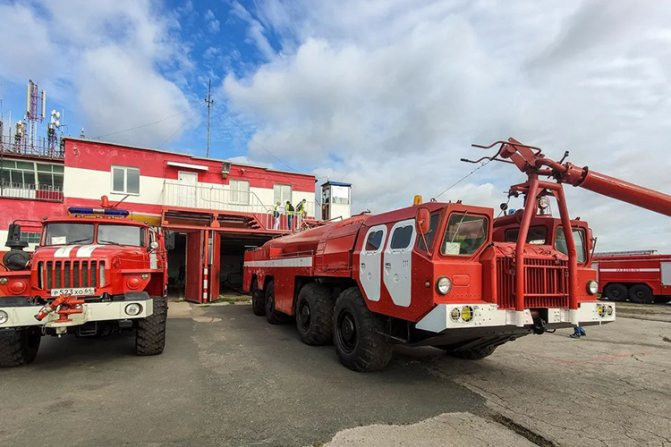
The car is adapted for work at any temperature. The main engine, pumps and tanks in the cold season are heated by an electric heating system, which is powered by a generator. In case of failure, heating from the gasoline system is possible.
The fire monitor can be operated manually or from the driver's cab. There are also portable installations in the amount of 2 pieces, which are used to extinguish fires in the salon or saloon, as well as in confined spaces.
Modifications AA-60
The main version of the AA-60 fire engine was improved several times and received three modifications:
- AA-60(543)-160. Heavy airfield fire truck based on MAZ-543 chassis. It has technical characteristics similar to the basic version, the main differences are the increased volume of the water tank, the capacity of which is 11 liters. Produced in limited edition.
- AA-60(7310)-160.01. Fire trucks for use at airfields, created directly on the basis of the MAZ 7310. The water supply here is 12 liters, and an autonomous pump has also been implemented. Produced for 000 years, in 4-1978.
- AA-60(7313)-160.01A. Another modification of the airfield fire engine, produced since 1982.

In 1986, the MAZ-7310 was replaced by the successor MAZ-7313, a 21-ton truck, as well as its modified version MAZ-73131 with a carrying capacity of almost 23 tons, all based on the same MAZ-543.
AA-70
This modification of the fire truck was also developed in the city of Priluki in 1981 on the basis of the MAZ-73101 chassis. This is an improved version of the AA-60, the main differences of which are:
- additional powder storage tank;
- decrease in water supply;
- high performance pump.
There are 3 tanks in the body: for powder with a volume of 2200 l, for foam concentrate 900 l and for water 9500 l.
In addition to extinguishing objects at the airfield, the machine can be used to extinguish racks with oil products, tanks with a total height of up to 6 m.

The operation of the special brigade MAZ 7310, carrying fire-fighting equipment on board, is carried out today at airfields for its intended purpose in many countries of the post-Soviet space. Such machines are not only adapted to the harsh climatic conditions of the northern regions, but also meet all the needs of the calculation in the fight against flames on aircraft and airfield facilities.
Intermediate and single line machines
Even before the appearance of the first modification, the designers applied various solutions to the basic technology, which led to the emergence of many small-scale variations.
- MAZ-543B - carrying capacity has been increased to 19,6 tons. The main purpose is the transportation of 9P117M launchers.
- MAZ-543V - the predecessor of the last successful modification had a cabin shifted forward, an elongated frame and an increased load capacity.
- MAZ-543P - a car of a simplified design was used for towing trailers, as well as for conducting exercises to train drivers of serious units. In a number of cases, the modification was exploited in the national economy.
- MAZ-543D is a single-seat model with a multi-fuel diesel engine. An interesting idea was not promoted because it was difficult to implement.
- MAZ-543T - the model is designed for comfortable movement in mountainous areas.
Features MAZ-543A

In 1963, an experimental modification of the MAZ-543A chassis was released. This model was intended for the installation of SPU OTRK "Temp-S". The MAZ-543A modification began to be produced in 1966, and mass production was launched only in 1968.
Especially to accommodate the new missile system, the base of the new model was slightly increased. Although at first glance there are no differences, in fact, the designers slightly increased the front overhang of the car by moving the cabs forward. By increasing the front overhang by 93 mm, it was possible to lengthen the useful part of the frame up to 7 meters.
New modifications of the MAZ-543A were intended primarily for the installation of the Temp-S launcher and the Smerch multiple launch rocket system on its bases. It should be noted that although the Temp-S launchers have long been decommissioned by the Russian Ground Forces, the Smerch multiple launch rocket systems are still in service with the Russian military.
The MAZ-543A modification was produced until the mid-2000s, in total about 2600 chassis were produced over the years. Subsequently, the following equipment was installed on the MAZ-543A chassis:
- Truck cranes of various carrying capacity;
- command posts;
- Communication complexes;
- Power plants;
- Various workshops.
In addition to the above, other specific military equipment was also installed on the basis of the MAZ-543A.
Maz 543 - Hurricane tractor: specifications, photo
Initially, the car was planned to be used only for the installation of missile systems, but later on the basis of the MAZ-543 new combat systems and an extensive range of auxiliary equipment were created, which made it the most massive and widespread vehicle of the Soviet Army.
The main advantages of this model are high power, design reliability, build quality and cross-country ability, adaptability to efficient operation in any road conditions and climatic zone, relatively low curb weight, achieved through the widespread use of alloy steels, aluminum and fiberglass truck.
Articles / Military equipment A car with a thousand faces: the military professions of MAZ tractors
Once upon a time, at military parades, MAZ-543 vehicles with new types of weapons literally every year presented foreign observers with another shocking "surprise". Until recently, these machines have firmly retained their high status and are still in service with the Russian army.
The design of a new generation of four-axle heavy-duty vehicles SKB-1 of the Minsk Automobile Plant under the leadership of chief designer Boris Lvovich Shaposhnik began in the early 1960s, and the organization of production of the 543 family became possible only with the transfer of production of MAZ-537 truck tractors to the Kurgan plant. To assemble new cars at MAZ, a secret workshop was formed, later transformed into the production of special wheeled tractors, and SKB-1 became the Office of the Chief Designer No. 2 (UGK-2).
MAZ-543 family
According to the general layout and the added base, the MAZ-543 family was a faster and more maneuverable transport modification of the MAZ-537G truck tractors, having received upgraded units, new cabs and a significantly increased frame length. A 525-horsepower D12A-525A V12 diesel engine, an automatic transmission with a modernized torque converter and a three-speed gearbox, new disc wheels on a torsion bar suspension with adjustable pressure on wide rims called a riveted-welded live frame were installed on the chassis with the original suspension.
The basis of the 543 family was the base chassis MAZ-543, MAZ-543A and MAZ-543M with new fiberglass side cabs with a reverse slope of the windshields, which became a kind of "calling card" of the entire model range. The cabins had right and left options, and two crew members were located according to the original tandem scheme, in individual chairs one after another. The free space between them was used to install the radiator and accommodate the front of the rocket. All cars had a single wheelbase of 7,7 meters, when fully loaded, they developed a speed on the highway of 60 km / h and consumed 80 liters of fuel per 100 km.
MAZ-543
The ancestor of the 543 family was a "light" base chassis with a carrying capacity of 19,1 tons with a simple MAZ-543 index. The first six prototypes were assembled in the spring of 1962 and sent to Volgograd to install the rocket system. The production of MAZ-543 cars began in the fall of 1965. In them, in front of the engine compartment, there were two two-door cabins isolated from each other, which predetermined a relatively small front overhang (2,5 m) and a mounting frame length of just over six meters. MAZ-543 cars were assembled in the amount of 1631 copies.
In the People's Army of the GDR, all-metal short bodies with a canopy and reinforced coupling devices were mounted on the MAZ-543 chassis, turning them into mobile recovery vehicles or ballast tractors.
At the first stage, the main purpose of this version was to carry experimental operational-tactical missile systems. The first of these was the mock-up system of the 9K71 Temp complex, followed by the 9P117 self-propelled launcher (SPU) of the new 9K72 complex.
The first samples of the Rubezh coastal missile system, a radio relay communication station, combat control points, a 9T35 combat crane, diesel power plants, etc. were also mounted on this base.
MAZ-543A
In 1963, the first sample of the MAZ-543A chassis with a carrying capacity of 19,4 tons was immediately under the installation of the SPU of the Temp-S operational-tactical missile system (OTRK), and later served as the basis for military corps and superstructures. Its industrial production began in 1966, and two years later it went into mass production.
The main difference between the car and the MAZ-543 model was the rearrangement of the undercarriage, imperceptible from the outside, due to a slight forward displacement of both cabs. This meant a meager increase in the front overhang (only 93 mm) and an extension of the useful part of the frame to seven meters. Until the mid-2000s, more than 2600 MAZ-543A chassis were produced.
The main and most serious purpose of the MAZ-543A was the transportation of the 9P120 OTRK Temp-S launcher and its cargo transport vehicle (TZM), as well as the TZM of the Smerch multiple launch rocket system.
An expanded set of military equipment was based on this vehicle: transport and installation units, truck cranes, mobile command posts, communications and defense vehicles for missile systems, radar equipment, workshops, power plants, and more.
Experimental and small-scale vehicles of the MAZ-543 family
In the late 1960s and early 1970s, the 543 family included several small-scale and experimental modifications. The first in alphabetical order were two prototypes of the MAZ-543B chassis, built on the basis of the MAZ-543 and used to install the improved 9P117M launcher of the 9K72 complex.
The main novelty was the little-known prototype MAZ-543V with a fundamentally different design and a carrying capacity of 19,6 tons, which served as the basis for the later known version of the MAZ-543M. Unlike its predecessors, for the first time it had a forward-biased single double cab, located on the left side next to the engine compartment. This arrangement made it possible to significantly lengthen the mounting part of the frame for the installation of larger equipment. Chassis MAZ-543V was assembled in the amount of 233 copies.
To carry out rear transport operations in the Soviet army and the national economy in the mid-1960s, a multi-purpose airborne version of the MAZ-543P dual-purpose was developed, which served as training vehicles or ballast tractors for towing artillery pieces and heavy trailers.
Little-known individual prototypes that did not receive development included the MAZ-543D chassis with a multi-fuel version of the standard diesel engine and the experimental "tropical" MAZ-543T for operation in mountainous desert areas.
MAZ-543M
In 1976, two years after the creation and testing of the prototype, the most successful, advanced and economical chassis MAZ-543M was born, which immediately went into production and into service, and then headed the entire 543 family. The new car differed from the first two machines 543/543А due to the installation of only the left cab, located next to the engine compartment and shifted to the front overhang of the frame, which reached its maximum (2,8 m). At the same time, all units and components have not changed, and the carrying capacity has increased to 22,2 tons.
Some modifications of this vehicle included an experimental multi-purpose chassis with an all-metal side platform from a civilian dual-purpose truck MAZ-7310.
MAZ-543M was the most powerful and modern domestic weapons systems and numerous specialized superstructures and van bodies. It was equipped with the most powerful Smerch multiple launch rocket system in the world, launchers of the Bereg coastal artillery system and the Rubezh missile system, various types of S-300 anti-aircraft guns, etc.
The list of auxiliary means for providing mobile missile systems was the most extensive: mobile command posts, target designation, communications, combat service, defense and security vehicles, autonomous workshops and power plants, mobile canteens and sleeping quarters for crews, combat and many others.
The peak of the production of MAZ-543M cars fell on 1987. Until the mid-2000s, the Minsk Automobile Plant assembled more than 4,5 thousand cars of this series.
The collapse of the Soviet Union stopped the mass production of the three MAZ-543 base chassis, but they continued to be assembled in small batches with orders to replenish the fleet of decommissioned vehicles, as well as to test new promising weapons systems on them. In total, in the mid-2000s, more than 11 thousand vehicles of the 543 series were assembled in Minsk, which housed about a hundred weapons systems and military equipment. Since 1986, under license, the Chinese company Wanshan has been assembling modified vehicles of the MAZ-543 series under the brand name WS-2400.
In 1990, on the eve of the collapse of the USSR, a 22-ton multi-purpose prototype MAZ-7930 was created with a multi-fuel V12 engine with a capacity of 500 hp and a multi-stage transmission from the Yaroslavl Motor Plant, a new monoblock cabin and a high-sided steel body.
Meanwhile, on February 7, 1991, the military unit of the Minsk Automobile Plant withdrew from the main enterprise and was transformed into the Minsk Wheel Tractor Plant (MZKT) with its own production facilities and research center. Despite this, in 1994, prototypes were tested, four years later they went into production, and in February 2003, under the brand name MZKT-7930, they were accepted for supply to the Russian army, where they serve to mount new weapons and superstructures.
Until now, the base machines of the MAZ-543 family remain in the production program of the MZKT and, if necessary, can be put on the conveyor again.
Various prototypes and small-scale vehicles produced on the basis of the MAZ-543
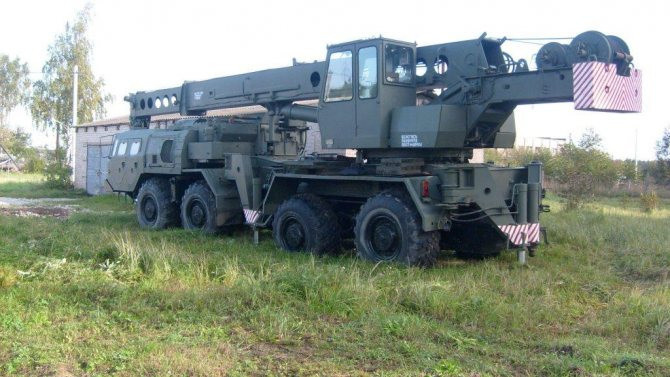
Since modernized launchers appeared in the early 70s, which differed in larger dimensions, the question arose of developing new modifications of the MAZ-543 chassis. The first experimental development was the MAZ-543B, assembled in the amount of 2 copies. They served as a chassis for installing the upgraded 9P117M launcher.
Since the new launchers required a longer chassis, the MAZ-543V modification soon appeared, on the basis of which the MAZ-543M was subsequently designed. The MAZ-543M modification was distinguished by the presence of a single-seat cabin, which was significantly shifted forward. Such a chassis made it possible to place larger objects or equipment on its base.
For various transport operations, both in the army and in the national economy, a small-scale modification of the MAZ-543P was developed. This machine had a dual purpose. It was used both for towing trailers and artillery pieces, and for training vehicles.
There were also practically unknown modifications, released in single copies as prototypes. These include a modification of the MAZ-543D, which has a multi-fuel diesel engine that could run on both diesel and gasoline. Unfortunately, due to the complexity of production, this engine never entered mass production.
Also interesting is the prototype MAZ-543T, the so-called "Tropic". This modification was specially designed to work in mountainous and desert areas.
Specifications and comparison with analogues
Military wheeled trucks, similar in terms of performance characteristics to the MAZ-537 tractor, also appeared abroad. In the United States, in connection with military needs, Mack began production of the M123 tractor and the M125 flatbed truck.
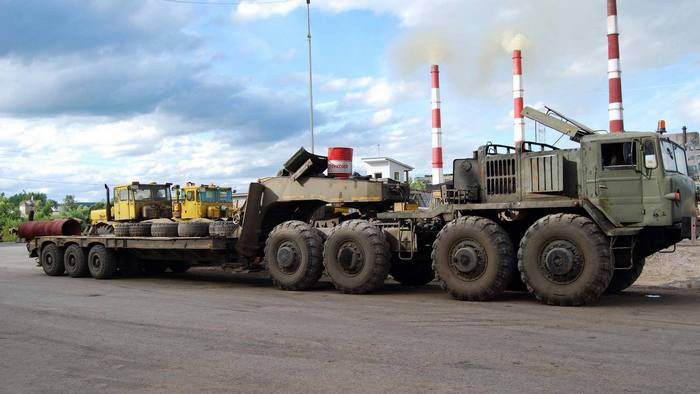
In the UK, the Antar was used to haul armored vehicles and as a ballast tractor.”
See also: MMZ - a trailer for a car: features, alteration, repair
| MAZ-537 | Mac M123 | Anthar Thorneycroft | |
| Weight, tons | 21,6 | 14 | twenty |
| Length meters | 8,9 | 7.1 | 8.4 |
| Width, m | 2,8 | 2,9 | 2,8 |
| Motor Power, hp | 525 | 297 | 260 |
| Maximum speed km / h | 55 | 68 | Four five |
| Power reserve, km | 650 | 483 | North Dakota. |
The American tractor was a machine of traditional design, created on automobile units. Initially, it was equipped with a carburetor engine, and only in the 60s the trucks were redone by installing a 300 hp diesel engine. In the 1970s, they were replaced by the M911 as a tanker tractor for US troops. The British Antar used a "simplified" eight-cylinder aircraft engine as an engine, the lack of power of which was already evident in the late 1950s.
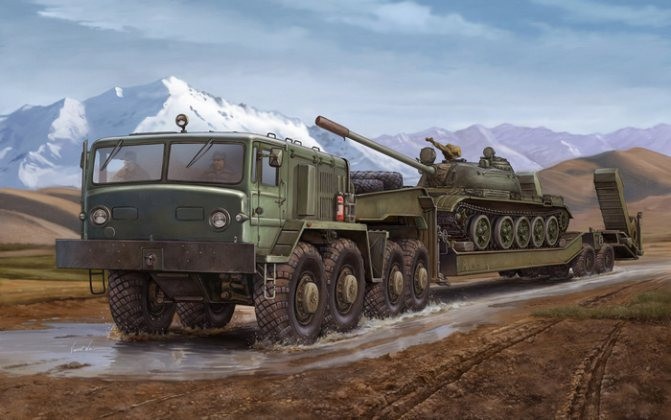
Later diesel-powered models increased speed (up to 56 km/h) and payload somewhat, but still had little success. However, it should be noted that the Antar was originally designed as a truck for oilfield operations, and not for military service.
The MAZ-537 is distinguished by a design adapted specifically for use in the army, high cross-country ability (“Antar” did not even have a front drive axle) and a large margin of safety.
For example, the M123, also designed to tow cargo weighing from 50 to 60 tons, had an automobile (not tank) engine of much lower power. Also striking is the presence of a hydromechanical transmission on a Soviet tractor.
MAZ-537 demonstrated the greatest potential of the designers of the Minsk Automobile Plant, who managed in a short time not only to develop a truck of the original design (MAZ-535), but also to quickly modernize it. And, although in Minsk they quickly switched to the production of "Hurricane", the continuation of the production of MAZ-537 in Kurgan confirmed its high qualities, and the KZKT-7428 truck became its worthy successor, proving that the potential of the design has not yet been revealed ahead has not yet been fully exhausted.
Features MAZ-543M
In 1976, a new and more popular modification of the MAZ-543 appeared. The prototype, called MAZ-543M, was tested for 2 years. This machine was put into service immediately after the debut. This modification has become the most successful of the MAZ-543 family. Its frame has become the longest in its class, and the vehicle's carrying capacity has increased to 22,2 tons. The most interesting thing in this model was that all components and assemblies were absolutely identical to the nodes of other models of the MAZ-543 family.
The most powerful Soviet launchers, anti-aircraft guns and various artillery systems were installed on the MAZ-543M chassis. In addition, several special add-ons were installed on this chassis. Over the entire period of production of the MAZ-543M modification, more than 4500 vehicles were produced.
Of great interest is the list of specific means of support installed on the MAZ-543M chassis:
- Mobile hostels are designed for 24 people. These complexes have systems of ventilation, microclimate, water supply, communications, microclimate and heating;
- Mobile canteens for combat crews.
These cars were used in remote areas of the USSR, where there were no settlements and there was nowhere to stay.
After the collapse of the Soviet Union, mass production of MAZ-543 vehicles of all three modifications was practically discontinued. They were produced strictly to order in small batches until the mid-2000s.
In 1986, the license to assemble the MAZ-543 was sold to the Chinese company Wanshan, which still produces them.
MAZ 537: price, specifications, photos, reviews, dealers MAZ 537
Technical characteristics of MAZ 537
| Year of construction | 1959 g |
| Body type | Tractor |
| Length, mm | 8960 |
| Width | 2885 |
| Height, mm | 2880 |
| Number of doors | two |
| Number of seats | 4 |
| Cargo space, l | — |
| Assembly country | the USSR |
Modifications MAZ 537
MAZ 537 38.9
| Maximum speed km / h | 55 |
| Acceleration time to 100 km / h, sec | — |
| Мотор | Diesel |
| Working volume, cm3 | 38880 |
| Power, horsepower / revolutions | 525/2100 |
| Moment, Nm/rev | 2200/1100-1400 |
| Consumption on the highway, l per 100 km | — |
| Consumption in the city, l per 100 km | — |
| Combined consumption, l per 100 km | 125,0 |
| Gearbox | Automatic, 3 gears |
| Drive unit | Full |
| Show all features |
Fire trucks MAZ-543 "Hurricane"
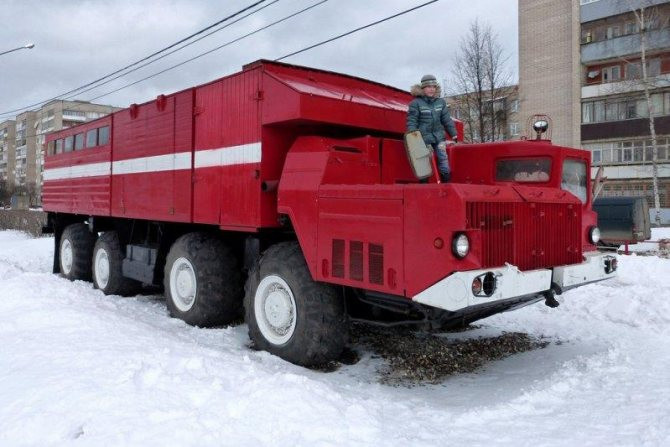
Fire trucks MAZ-543 "Hurricane" were designed specifically for service at Soviet airfields. Many machines of this series are still in operation at the airfields of the CIS. MAZ-543 firefighters have a 12 liter water tank. There is also a 000 liter foam tank. Such features make these support vehicles indispensable in the event of a sudden fire at the airport. The only negative is the high fuel consumption, which reaches 900 liters per 100 kilometers.

Currently, cars of the MAZ-543 family are gradually being replaced by new MZKT-7930 cars, although this process is very slow. Hundreds of MAZ-543s continue to serve in the armies of Russia and the CIS countries.
Basic Modifications
Today there are two main models and several small-scale versions.
MAZ 543 A
In 1963, the first improved version of the MAZ 543A was introduced, with a slightly higher carrying capacity of 19,4 tons. A little later, that is, since 1966, various variations of military equipment began to be produced on the basis of modification A (hotel).
Thus, there are not so many differences from the base model. The first thing you'll notice is that the cabs have moved forward. This made it possible to increase the useful length of the frame to 7000 mm.
I must say that the production of this version was massive and continued until the early 2000s, in total no more than 2500 parts rolled off the assembly line.
Basically, the vehicles served as missile carriers for the transportation of missile weapons and all kinds of equipment. In general, the chassis was universal and was intended for the installation of various types of superstructures.
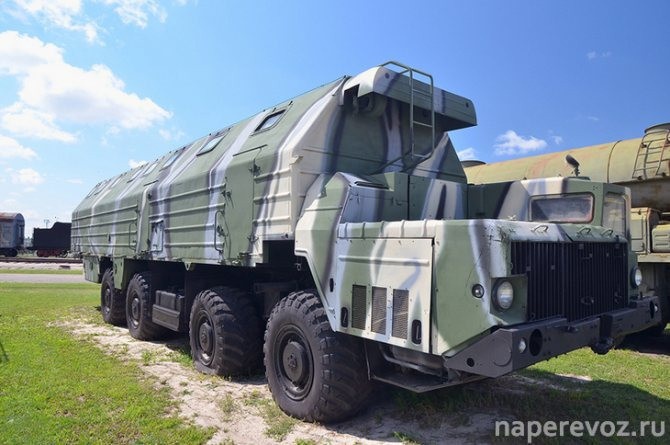
MAZ 543 M
The golden mean of the entire 543 line, the best modification, was created in 1974. Unlike its predecessors, this car had only a cab on the left side. Carrying capacity was the highest, reaching 22 kg without taking into account the weight of the car itself.
In general, no major structural changes were observed. On the basis of the MAZ 543 M, the most formidable weapons and all kinds of additional superstructures have been produced and are still being created. These are SZO "Smerch", S-300 air defense systems, etc.

For all the time, the plant produced at least 4,5 thousand pieces of the M series. With the collapse of the USSR, mass production was stopped. All that remained was the production of small batches commissioned by the state. By 2005, a total of 11 thousand various variations based on the 543 family had rolled off the assembly line.
On the chassis of a military truck with an all-metal body, the MAZ 7930 was developed in the 90s, on which a more powerful engine (500 hp) was installed. The release into mass production of the version, called the MZKT 7930, did not stop even the fact of the collapse of the USSR. The release continues to this day.

